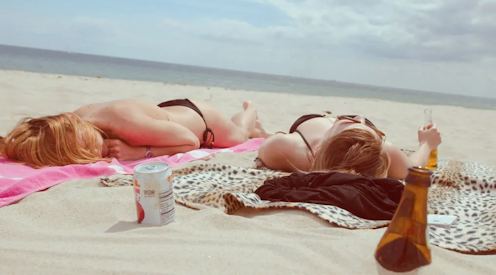
Depending upon where you are in Europe, the practice of sunbathing topless is more or less acceptable. Brits, for example, have a record of struggling to ditch the bikini top by comparison to their more brazen European neighbours.
Yet even on what the English describe as “The Continent”, exposing one’s breasts is fraught with peril. As a French sociologist researching naturism, I am fascinated by the thin line that turns bare breasts into a political statement, such as with FEMEN activists, or simple bathing practice to avoid pesky tan lines.
Bare breasts tolerated at the beach
The beach is one of the few places where it’s not inappropriate to lie partially unclothed next to strangers. That space-time is set out by the sand, turned strict, impenetrable boundary beyond which certain practices, such as exposing the body in a swimming costume, or even more so when it comes to bare breasts, are unacceptable.
On the beach, it is therefore possible to be naked without offending public decency. So how can women go topless on the beach without being eroticized by all the men around them? Because “the exposure of nudity”, according to the sociologist Jean-Claude Kaufmann, “makes the nude less apparent”. When reunited, specific conditions can normalise, if not make breasts invisible. One of the most common arguments women will resort to to justify topless sunbathing is that “We’re all made the same”. Kaufmann concludes that “normalisation stems from breasts’ impersonality in general. The archaic visual attraction would then only be due to the scarcity of the good which, now abundant, is no longer attractive”
However, this apparent liberation is in reality nothing more than the displacement of norms from external frameworks to intimate reflexes. Stripping naked at the beach represents a process of civilisation and self-control, since people can see themselves almost naked without showing any sexual response. It is proof of control, internalisation and even repression of immediate impulses.
Exposing one’s naked breasts on the beach is by no means innocent and requires mastering specific techniques. When it comes to positioning oneself, lying down is the most intimate position. For women who practise it, standing up has a different connotation: they are watched more and many get dressed as soon as they have risen on their feet.
Bear in mind that there are some exceptions to this rule: tolerance is bound to be greater if the woman is walking with a specific intent, rather than wandering aimlessly, and even more so if the movement is spontaneous - such as springing to one’s feet to chase after a parasol that has flown away. It may also be acceptable if the distance covered is not too great, with some women sitting on the edge of the shore to shorten the journey to the bath. What’s more, the attitude you adopt is crucial: to stand up and remain topless, you mustn’t drag your feet. In short, you mustn’t look like you’re trying to show off.
The weight of the male gaze
Despite this learning of specific techniques, the practice of toplessness, which first appeared in St Tropez in the 1960s, declined sharply in the 2000s. According to 2021 survey of over 1,500 women, while 43% of women said they regularly went topless on the beach in 1984, only 19% did so in 2019. So the phenomenon is now out of fashion. But why?
Initially, it would appear that medical advice to protect oneself from the sun has had a strong impact, with 56% of French women surveyed citing the risks to the skin from the sun as a reason for not going topless. However, while this argument is indeed the first to be mentioned, it would appear that the way other people look at you, particularly men, is actually the biggest obstacle. For example, 35% of women cited “men’s lustful stares”, 28% cited “fear of negative criticism” of their appearance, 27% cited “fear of being the object of criticism” and 25% cited “fear of being the object of criticism” and “fear of being subjected to verbal, physical or sexual aggression ” and 23% mention “fear of being perceived as an immodest or indecent woman”.
The gaze of others is all the more important when the question is asked of people under 25, with medical risks only coming in fourth place behind the gaze of men (59%), fear of being attacked (51%) and fear of negative criticism of their appearance (41%). On the beach, we can identify the boundaries between what can be done and what is not advisable. These boundaries are geographical (the sand) and morphological (women may be deemed too old or their breasts too large to be acceptable to show).
So, while giving the impression of looking at nothing but the overall landscape, everyone is in fact checking out what’s going on all around them, and the slightest difference in behaviour or morphology catches the eye, no matter how much the person may wish not to look. Everyone is watching everyone else and everyone is watching how they are being watched. In reality, there is very little communication through words; almost everything is in the eyes. For example, breasts, which are usually hidden, attract attention when they are naked. They therefore imply an effort to control the gaze and the emotions, but they don’t have to be seen as such. The beach is “the art of seeing without seeing”. There is no such thing as an action that is banal by nature. As such, “stripping off on the beach is not a simple, natural, problem-free gesture, but rather part of a historical process and a set of extraordinarily sophisticated rules of behaviour, defining who has the right to do what and how”, to quote Jean-Claude Kaufmann.
Although toplessness at the beach may encourage a desexualisation of nudity, this desexualisation is not systematic and requires a learning process on the part of both practitioners and observers.
Thelma Bacon ne travaille pas, ne conseille pas, ne possède pas de parts, ne reçoit pas de fonds d'une organisation qui pourrait tirer profit de cet article, et n'a déclaré aucune autre affiliation que son organisme de recherche.
This article was originally published on The Conversation. Read the original article.







